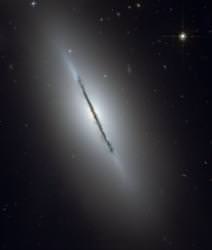Imagine suddenly realizing that your house was twice as big as you originally thought. Okay, maybe that’s a little out there, but astronomers from Australia have calculated that the Milky Way is actually twice as thick as previously believed – doubling from the originally estimated 6,000 light-years to 12,000 light-years.
The calculation was made by a couple of astronomers from the University of Sydney. They were working with the accepted numbers for the dimensions of our home galaxy (6,000 light years thick, and 100,000 light-years wide) when they thought it might make sense to double check those basic assumptions.
They used an accepted technique for calculating distance; measuring the light from pulsars. When light from distant pulsars moves through the background material of the Milky Way (known as the Warm Ionised Medium), it slows down. The redder pulses of light actually slow down more than the bluer pulses.
By measuring the change in light from the pulsar, astronomers can determine how much material the light has traveled through.
When they used the old calculations for 40 different pulsars inside and above it, they got the old numbers. But when they just looked at 17 pulsars which are above and below the galactic disk they got a new, more accurate, estimate.
“Of the thousands of pulsars known in and around our Galaxy, only about 60 have really well known distances,” said Professor Bryan Gaensler. “But to measure the thickness of the Milky Way we need to focus only on those that are sitting above or below the main part of the Galaxy; it turns out that pulsars embedded in the main disk of the Milky Way don’t give us useful information.”
Their results were presented in January at the annual meeting of the American Astronomical Society in Austin, Texas. Some of Dr. Gaensler’s colleagues appreciated the revised calculations, while others… not so pleased at the implications for their own research.
Original Source: University of Sydney


I assume that the new calculation doesn’t change the mass of the Milky Way much, if at all, just by how much it is spread out?
Does this “new geometry” of our Galaxy have any impact on the guess of how many stars our Galaxy contains?
Does this calculation have implications for the “Dark Matter” theory? Or will calculations simply adjust down the amount of dark matter assumed (sounds sort of like fudging on your homework)
For years I’ve been told that size doesn’t matter.
Oh well….
Re: ‘checking those basic assumptions’
Last week, the Astronomical Unit, this week, the Milky Way, next week, Theory of Evolution?
There is much to learn.
Yes Eileen.
Nothing is absolutely right or wrong but everything is necessary.
“eileen Says:
February 24th, 2008 at 8:24 am
Re: ‘checking those basic assumptions’
Last week, the Astronomical Unit, this week, the Milky Way, next week, Theory of Evolution?”
There is no doubt at all that, like your examples given, the T.O.E will undergo some modification and refinement over the years based on fresh evidence and refined research approaches. That very freedom to refine ideas based on evidence and not get tied down to todays ‘truths’ is where science derives its strength from.
The likely fact that almost all of these future observations and evidence will fit perfectly within Evolution’s existing framework, and the rest with only minor modification to it is testament to the power, elegance and profoundity of The Theory.
So, How many stars does our milky way galaxy contain after these modifications?